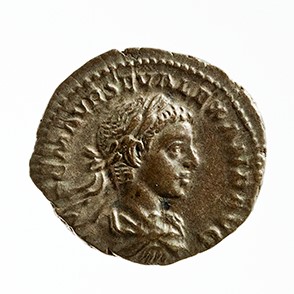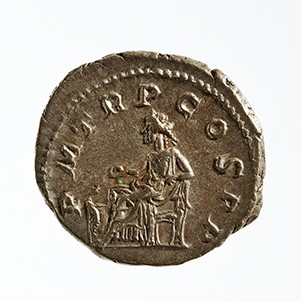Acquisition number: 1966.56
Obv.: Bust of Severus Alexander r., laureate, draped. IMP(erator) C(aesar) M(arcus) AVR(elius) SEV(erus) ALEXAND(er) AVG(ustus).
Rev.: Salus sitting l., on a throne, draped, with patera (shallow dish for offerings) in right hand feeding snake coiled around altar in front of her, left elbow on arm of throne. P(ontifex) M(aximus) TR(ibunicia) P(otestate) CO(n)S(ul) P(ater) P(atriae).
Title: Denarius of Severus Alexander - 1966.56
Acquisition number: 1966.56
Author or editor: Beryl Rawson
Culture or period: Roman Imperial
Date: AD 222
Material: Metal - Silver
Object type: Coins - Roman
Dimensions: 20mm (w)
Origin region or location: Italy
Origin city: Rome
Display case or on loan: 7
Keywords: Coin, denarius, Roman, Imperial, Severus Alexander, Salus
Sear, D.R., Roman Coins and their Values 5 vols (London, Spink, 2000-2014) 7894; Mattingly, H.,Coins of the Roman Empire in the British Museum, 6 vols (London, 1965) VI 34, pl. 2, no. 34; Seaby, H.A., Roman Silver Coins (London, B.A. Seaby, 1967) III 218; Mattingly, H., E.A. Sydenham, C.H. Sutherland, R.A. Carson, The Roman Imperial Coinage 13 vols (London, Spink, 1923-1994) IV 72 no. 14(c); Robertson, A. Roman Imperial Coins in the Hunter Coin Cabinet, University of Glasgow 5 vols (Oxford: Oxford University Press, 1962-1982) III 137 no. 7 and pl. 41.
1966.56
Denarius of Severus Alexander
2.877 g. AD 222
Obv.: Bust of Severus Alexander r., laureate, draped. IMP(erator) C(aesar) M(arcus) AVR(elius) SEV(erus) ALEXAND(er) AVG(ustus).
Rev.: Salus sitting l., on a throne, draped, with patera (shallow dish for offerings) in right hand feeding snake coiled around altar in front of her, left elbow on arm of throne. P(ontifex) M(aximus) TR(ibunicia) P(otestate) CO(n)S(ul) P(ater) P(atriae).
Severus Alexander was the popular cousin of Elagabalus and another grandson of Julia Maesa. He was appointed Caesar under Elagabalus (AD 221) and succeeded him in 222. His name claims connection with the Antonine and Severan dynasties.
The annual enumeration of tribunician power facilitates dating of Alexander’s coins. In this his first year as emperor he used mainly conventional types.
Sear, D.R., Roman Coins and their Values 5 vols (London, Spink, 2000-2014) 7894; Mattingly, H.,Coins of the Roman Empire in the British Museum, 6 vols (London, 1965) VI 34, pl. 2, no. 34; Seaby, H.A., Roman Silver Coins (London, B.A. Seaby, 1967) III 218; Mattingly, H., E.A. Sydenham, C.H. Sutherland, R.A. Carson, The Roman Imperial Coinage 13 vols (London, Spink, 1923-1994) IV 72 no. 14(c); Robertson, A. Roman Imperial Coins in the Hunter Coin Cabinet, University of Glasgow 5 vols (Oxford: Oxford University Press, 1962-1982) III 137 no. 7 and pl. 41.

